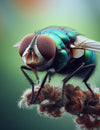
1. Introduction to Malaria Mosquitoes
Malaria, a life-threatening disease transmitted through the bites of infected mosquitoes, continues to be a global health concern. One crucial aspect of combating malaria is the ability to identify the mosquitoes responsible for its transmission. In this section, we'll delve into the importance of distinguishing between normal mosquitoes and those carrying the malaria parasite.
Understanding the Importance of Identification
Identification plays a pivotal role in the effective management and prevention of malaria. While various species of mosquitoes exist, only a select few are vectors for the Plasmodium parasites responsible for malaria transmission. Knowing how to differentiate between normal mosquitoes and their malaria-carrying counterparts is essential for implementing targeted control measures.
Differentiating Between Normal and Malaria Mosquitoes
Normal mosquitoes, often considered a nuisance due to their itchy bites, belong to diverse species. On the other hand, malaria mosquitoes, primarily the Anopheles genus, pose a more significant threat as carriers of the Plasmodium parasites. Recognizing the subtle but distinctive differences in their physical characteristics and behaviors is crucial for individuals, communities, and health organizations working towards malaria prevention.
Understanding these nuances allows for the implementation of specific preventive strategies tailored to the unique characteristics of malaria mosquitoes. In the following sections, we will explore the physical attributes, behaviors, and geographical distribution that set normal and malaria mosquitoes apart, providing readers with the knowledge needed to identify and address this critical public health issue effectively.
2. Physical Characteristics of Normal Mosquitoes
Normal mosquitoes, despite being a common annoyance, exhibit certain physical characteristics that distinguish them from their malaria-carrying counterparts. Understanding these features is a crucial step in accurate mosquito identification.
Size and Coloration
Normal mosquitoes typically have a smaller and more inconspicuous appearance compared to malaria mosquitoes. Their coloration varies but often includes shades of brown, grey, or even black. The size and color can vary between species, but the key is to recognize that normal mosquitoes tend to be less noticeable than their malaria-carrying counterparts.
Wing Shape and Features
Examining the wings is another useful method for identifying normal mosquitoes. Their wings often have a characteristic shape and vein pattern. In normal mosquitoes, the wings may be clear or have subtle markings, but they lack the distinct features found in the wings of malaria mosquitoes.
Proboscis Structure
The proboscis, or mouthparts, of normal mosquitoes is adapted for piercing the skin and drawing blood. However, these structures are generally less specialized than those of malaria mosquitoes. The absence of specific adaptations for efficient blood feeding is a notable characteristic when distinguishing normal mosquitoes.
Understanding these physical traits is the first step in differentiating between normal and malaria mosquitoes. In the next section, we will explore the distinctive physical characteristics of malaria mosquitoes, providing a comprehensive guide for accurate identification and targeted prevention strategies.
3. Physical Characteristics of Malaria Mosquitoes
Malaria mosquitoes, primarily belonging to the Anopheles genus, exhibit distinct physical features that set them apart from their non-malarial counterparts. Recognizing these characteristics is essential for implementing targeted prevention measures.
Size and Coloration Differences
Malaria mosquitoes are often larger than normal mosquitoes, with a wingspan that can be more pronounced. Their coloration tends to be darker, with a mix of browns and blacks. This visual contrast, especially in size and color, becomes a key factor in distinguishing them from other mosquito species.
Distinctive Markings on the Body
An important feature of malaria mosquitoes is the presence of specific markings on their bodies. These markings may include spots, stripes, or other patterns that are species-specific. These distinctive features aid entomologists and healthcare professionals in accurately identifying the species responsible for malaria transmission in a particular region.
Notable Features of the Antennae
The antennae of malaria mosquitoes often possess unique characteristics that differ from those of normal mosquitoes. These adaptations play a role in their ability to locate suitable hosts for blood-feeding. By examining the antennae, experts can further refine their identification of malaria mosquitoes, contributing to targeted interventions for malaria prevention.
Understanding the physical characteristics of malaria mosquitoes is a critical aspect of mosquito identification. In the following sections, we will explore the behavioral disparities between normal and malaria mosquitoes, providing a comprehensive guide for individuals and communities striving to minimize the risk of malaria transmission.
4. Behavioral Differences Between Normal and Malaria Mosquitoes
Beyond their physical attributes, the behaviors of normal and malaria mosquitoes also differ significantly. Recognizing these distinctions is crucial for developing effective strategies to mitigate the risk of malaria transmission.
Feeding Habits
Normal Mosquitoes: Typically, normal mosquitoes feed on the nectar of flowers, sustaining themselves on plant-based substances. The females, however, require a blood meal for egg development.
Malaria Mosquitoes: Female malaria mosquitoes, belonging to the Anopheles genus, seek blood meals to nourish their eggs. It is during this blood-feeding process that the transmission of the Plasmodium parasites, the causative agents of malaria, occurs.
Understanding the different feeding habits of these mosquitoes allows for the development of targeted preventive measures that disrupt the transmission cycle of malaria.
Activity Patterns
Normal Mosquitoes: These mosquitoes are often most active during the evening and night, with their buzzing presence becoming noticeable during warm weather.
Malaria Mosquitoes: Anopheles mosquitoes, carriers of the malaria parasite, tend to be active during the night as well, increasing the likelihood of encountering humans during their sleep, making them efficient vectors for malaria transmission.
Preferred Breeding Environments
Normal Mosquitoes: Commonly, normal mosquitoes lay their eggs in stagnant water sources like ponds, birdbaths, or containers with standing water.
Malaria Mosquitoes: The Anopheles mosquitoes, on the other hand, prefer a broader range of breeding environments, including both stagnant and slow-flowing water bodies. Understanding these preferences aids in targeted efforts to eliminate breeding sites and reduce the overall mosquito population.
By recognizing and leveraging these behavioral disparities, communities and individuals can implement preventive measures that specifically address the unique traits of malaria mosquitoes, contributing to more effective malaria control initiatives. In the subsequent sections, we will explore the geographical distribution of malaria mosquitoes and the health implications of their bites, providing a comprehensive understanding for readers seeking to protect themselves and their communities.
5. Methods for Identifying Malaria Mosquitoes
Accurate identification of malaria mosquitoes is a crucial step in implementing targeted control measures and preventing the transmission of this life-threatening disease. Various methods and tools are available for identifying these mosquitoes, ranging from visual inspection to advanced surveillance techniques.
Visual Identification Tips
Visual identification remains a fundamental method for distinguishing malaria mosquitoes from their non-malarial counterparts. Key features to look for include size, coloration, and distinctive markings on the body. Field guides and online resources can aid individuals in becoming proficient in recognizing the physical characteristics unique to malaria mosquitoes.
Utilizing Mosquito Traps and Surveillance Tools
Modern technology has facilitated the development of mosquito traps and surveillance tools designed specifically for the identification of malaria vectors. These traps often use attractants such as carbon dioxide or body odors to lure mosquitoes, enabling researchers and health professionals to collect and identify them accurately. Surveillance tools, including genetic analysis and molecular techniques, further enhance the precision of identification.
Seeking Professional Assistance
For precise identification and comprehensive mosquito surveillance, seeking the expertise of entomologists and public health professionals is invaluable. These individuals possess the knowledge and skills to identify mosquito species accurately, assess their potential for transmitting diseases like malaria, and recommend appropriate control measures.
Efforts in identifying malaria mosquitoes not only aid in preventing the spread of the disease but also contribute to the overall understanding of mosquito ecology and behavior. In the subsequent sections, we will explore preventive measures against malaria, including mosquito repellents, bed nets, and environmental control strategies, empowering readers with actionable steps to protect themselves and their communities.
6. Preventive Measures Against Malaria
Implementing preventive measures is crucial to minimize the risk of malaria transmission. By understanding and addressing the unique characteristics of malaria mosquitoes, individuals and communities can significantly reduce the incidence of this life-threatening disease.
Mosquito Repellents and Bed Nets
1. Mosquito Repellents: The use of insect repellents containing DEET, picaridin, or other effective ingredients can provide a protective barrier against mosquito bites. Applying repellents to exposed skin and clothing, particularly during peak mosquito activity hours, is an effective preventive measure.
2. Bed Nets: Sleeping under insecticide-treated bed nets is a proven strategy to prevent mosquito bites, especially during the night when malaria mosquitoes are most active. The nets create a physical barrier and provide an additional layer of protection against malaria transmission.
Environmental Control and Habitat Modification
1. Eliminating Breeding Sites: Regularly inspecting and eliminating potential mosquito breeding sites, such as stagnant water in containers, gutters, or ponds, can significantly reduce mosquito populations. This is especially important for normal mosquitoes with distinct breeding preferences.
2. Environmental Management: Implementing environmental management practices, such as draining standing water and keeping surrounding areas clean, disrupts the mosquito life cycle. This targeted approach is effective in reducing both normal and malaria mosquito populations.
Vaccination and Medication Options
1. Malaria Vaccination: In regions where malaria is prevalent, vaccination programs can provide an additional layer of protection. Vaccines like RTS,S/AS01 have shown effectiveness against specific Plasmodium species.
2. Antimalarial Medications: For individuals residing in or traveling to malaria-endemic areas, taking antimalarial medications as prescribed by healthcare professionals is essential. These medications act as a preventive measure, reducing the risk of contracting malaria.
Understanding and implementing these preventive measures contribute to comprehensive malaria control efforts. In the final sections, we will explore educational initiatives for malaria prevention and offer a conclusive recap of key identification and prevention points, empowering readers to take proactive steps in safeguarding their health and well-being.



